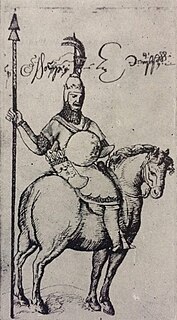Mamia I Dadiani (Georgian :მამია I დადიანი; died 1345) was a member of the House of Dadiani and eristavi ("duke") of Odishi in western Georgia from 1323 until his death.

Georgian is a Kartvelian language spoken by Georgians. It is the official language of Georgia. Georgian is written in its own writing system, the Georgian script. Georgian is the literary language for all regional subgroups of Georgians, including those who speak other Kartvelian languages: Svans, Mingrelians and the Laz.

The House of Dadiani was a Georgian family of nobles, dukes and princes, and a ruling dynasty of the western Georgian province of Samegrelo (Mingrelia) or Odishi.

Eristavi was a Georgian feudal office, roughly equivalent to the Byzantine strategos and normally translated into English as "duke". In the Georgian aristocratic hierarchy, it was the title of the third rank of prince and governor of a large province. Holders of the title were ex-officio commanders of a military 'banner', wore a distinctive dress, ring, belt and spear and rode a particular breed of horse.
Mamia succeeded as duke of Odishi, latter-day Mingrelia, on the death of his father, Giorgi I Dadiani, in 1323. This was the time when a civil war was raging in the Kingdom of Imereti, of which Odishi was part, between King Constantine and his brother Michael. According to the early-18th-century historian Prince Vakhushti, this situation was exploited by Giorgi I Dadiani to assert the Dadiani's autonomy, which was further consolidated by Mamia I. By that time, he held sway not only over Odishi proper; his influence extended south into Guria and north into Abkhazia. In 1330, however, Imereti and its vassal principalities were reintegrated by the resurgent King of Georgia, George V "the Brilliant", to whom Dadiani offered his submission. Mamia died in 1345 and his son, Giorgi II was confirmed by the king of Georgia as his successor. [1] [2]

The Principality of Mingrelia, also known as Odishi, was a historical state in Georgia ruled by the Dadiani dynasty. Established as an independent Principality in 1557 by Levan I Dadiani as a hereditary mtavari (Prince), it remained independent until it became subject to Imperial Russia in 1803. The principality ultimately came to an end when Prince Niko Dadiani was deposed, and the principality abolished, by Russia in 1867. Prince Niko officially renounced his rights to the throne in 1868.
Giorgi I Dadiani was a member of the House of Dadiani and eristavi ("duke") of Odishi in western Georgia from the late 13th century until his death.

The Kingdom of Imereti was a Georgian monarchy established in 1455 by a member of the house of Bagrationi when the Kingdom of Georgia was dissolved into rival kingdoms. Before that time, Imereti was considered a separate kingdom within the Kingdom of Georgia, to which a cadet branch of the Bagrationi royal family held the crown. This started in 1260 after David VI revolted against Mongolian rule and fled to Abkhazia. This was the result of the Mongolian conquest of Georgia during the 13th century which decentralized and fragmented Georgia, forcing the relocation of governmental centres to the provinces.


